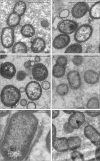Gingimaps: Protein Localization in the Oral Pathogen Porphyromonas gingivalis
- PMID: 31896547
- PMCID: PMC6941882
- DOI: 10.1128/MMBR.00032-19
Gingimaps: Protein Localization in the Oral Pathogen Porphyromonas gingivalis
Abstract
Porphyromonas gingivalis is an oral pathogen involved in the widespread disease periodontitis. In recent years, however, this bacterium has been implicated in the etiology of another common disorder, the autoimmune disease rheumatoid arthritis. Periodontitis and rheumatoid arthritis were known to correlate for decades, but only recently a possible molecular connection underlying this association has been unveiled. P. gingivalis possesses an enzyme that citrullinates certain host proteins and, potentially, elicits autoimmune antibodies against such citrullinated proteins. These autoantibodies are highly specific for rheumatoid arthritis and have been purported both as a symptom and a potential cause of the disease. The citrullinating enzyme and other major virulence factors of P. gingivalis, including some that were implicated in the etiology of rheumatoid arthritis, are targeted to the host tissue as secreted or outer-membrane-bound proteins. These targeting events play pivotal roles in the interactions between the pathogen and its human host. Accordingly, the overall protein sorting and secretion events in P. gingivalis are of prime relevance for understanding its full disease-causing potential and for developing preventive and therapeutic approaches. The aim of this review is therefore to offer a comprehensive overview of the subcellular and extracellular localization of all proteins in three reference strains and four clinical isolates of P. gingivalis, as well as the mechanisms employed to reach these destinations.
Keywords: OMV; P. gingivalis; PPAD; Porphyromonas gingivalis; protein sorting; proteome.
Copyright © 2020 American Society for Microbiology.
Figures







References
-
- Dominy SS, Lynch C, Ermini F, Benedyk M, Marczyk A, Konradi A, Nguyen M, Haditsch U, Raha D, Griffin C, Holsinger LJ, Arastu-Kapur S, Kaba S, Lee A, Ryder MI, Potempa B, Mydel P, Hellvard A, Adamowicz K, Hasturk H, Walker GD, Reynolds EC, Faull RLM, Curtis MA, Dragunow M, Potempa J. 2019. Porphyromonas gingivalis in Alzheimer’s disease brains: evidence for disease causation and treatment with small-molecule inhibitors. Sci Adv 5:eaau3333. doi:10.1126/sciadv.aau3333. - DOI - PMC - PubMed
-
- van Winkelhoff AJ, Loos BG, van der Reijden WA, van der Velden U. 2002. Porphyromonas gingivalis, Bacteroides forsythus, and other putative periodontal pathogens in subjects with and without periodontal destruction. J Clin Periodontol 29:1023–1028. doi:10.1034/j.1600-051x.2002.291107.x. - DOI - PubMed
Publication types
MeSH terms
Substances
LinkOut - more resources
Full Text Sources
Medical
Molecular Biology Databases

